We have about had our fill of the glitzy overdeveloped feel of Gatlinburg, Pigeon Forge and Seiverville so we take a ride to a space a little more rural. We check out the visitor center and find a great volunteer who obviously loves talking about the town and gives us some fun tips on sightseeing. We choose the Tinsley Bible Drug Company Soda Shop for lunch. What fun! The food was delicious; a Bible Burger, chili, a malt and a sundae both made with Blue Bell ice cream. The experience and atmosphere even better. The place was full of locals who, along with the long time waitstaff, did a lot of talking. Try it if you find yourself near here. BTW, The store and Bible burger are named after one of the pharmacists back in the day.
TVA Small Wild Areas
Tennessee Valley Authority is the COE of this area. We discovered today that they call their developed recreation areas around lakes and dams Small Wild Areas. We checked out a short trail at the Douglas Lake headwaters today. Not bad. We will have to be on the watch for them in the future.
Classic SMNP – Black Bears!
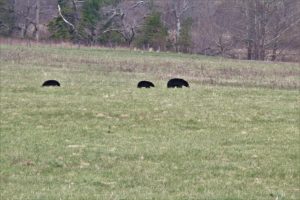 We just had to cruise to Cades Cove because you know, everybody does. Traffic is pleasantly light and we are delighted at the only stoppage, a bear jam. We get a nice look at a mama bear and two yearlings moving through the meadow not far off the road. We stop for a picnic lunch along the Little River then head on home. Not quite yet. Another bear jam. A lone cub/yearling is foraging just off the road. He looks cute, small and a bit lonesome but here’s hoping he will be just fine.
We just had to cruise to Cades Cove because you know, everybody does. Traffic is pleasantly light and we are delighted at the only stoppage, a bear jam. We get a nice look at a mama bear and two yearlings moving through the meadow not far off the road. We stop for a picnic lunch along the Little River then head on home. Not quite yet. Another bear jam. A lone cub/yearling is foraging just off the road. He looks cute, small and a bit lonesome but here’s hoping he will be just fine.
Smoky Mountain National Park
Wildflowers
We rarely, maybe never before chose trails based on wildflower sightings but just have to give it a try here. SMNP is renowned for the variety of wildflowers found here (1400 recorded) and we are right in the heart of spring season.
We choose two Creekside trails, Porters Creek and Little River Trails. The sound of tumbling, gurgling water fills the air as we inspect the earth either side of the trail for all signs of color. Sometimes it is an isolated bloom or a small cluster in a sheltered crack or along a stump and other times a whole area is blanketed with color. It is great fun. Kent has a lot of pics for me to identify but that will take a while. I will add a note later. Evidence of previous land use dot the trail-sides adding interest to the walk: stone chimneys, rock walls, cemeteries and old foundations.
On Porters Creek we turned back as the sky darkened. A fellow enthusiast we met on the trail informed us we turned just a fraction of a mile early and missed an area blanketed with felicia…….but we beat the rain as the first drops hit while we got into the car.
One more trail, Chestnut Top. It is a steep, sunny south slope so the walk is a bit more taxing but it has a nice sampling of flowers including a couple varieties not seen Creekside.
I think we might do wildflower looking again sometime.
Birding from our window
Our site at Douglas Lake is along the riverbank with a lovely view and a fair number of birds to watch. Gold finches flit around the tree tops, wood peckers rat-a-tat, eagles soar, cormorants glide up and down river just above the water surface, and a group of great blue heron fish diligently to feed the young in the nearby rookery. Did you know that the heron actually lands in deep water sometimes? It is not very graceful to watch but must be an effective hunting method. We watched them do it repeatedly. In the evenings a tom turkey is first heard then seen strutting and he stays at it for hours attracting and wooing just one female. One morning we hear and watch 8 toms (not sure if our lone evening fellow is in with them) and at least 10 females puffing and strutting and racing about. No TV channels here but the bird watching is better than most shows anyway.
Moving on
Time to pack-up then we head on to Great Smoky National Park. We are staying at the TVA Douglas Lake tailwaters park just north of Seiverville; about a 6-hour drive. All goes smoothly until we are about 10 miles from camp. A truck driver merges in beside us then as he passes motions to Kent – pointing down. Rats, that is not usually good. Sure enough, we have a flat on the trailer. The shoulder is narrow but it is a curb side tire, Kent is going to change it. 30 minutes and we are back on our way. Nice job, Kent. There will be a trip to a tire store in our near future but we make our way to camp with no further incident.
Four Holes Swamp
Seems nobody knows exactly why it’s call that.
This is a beautiful swamp. 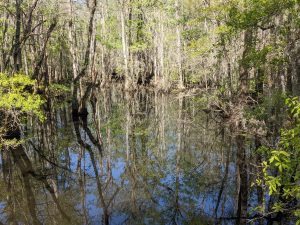 The Francis Beidler Forest is flooded by rainwater channeled through the forest by crisscrossing, meandering creeks rather than the roiling, rising waters in a flood plain like Congaree swamp. Here, reflections fill the surface of clear blackwater flowing slowly around huge bald cypress, tupelo and red maple trees. There is no tangle of fallen and flood strewn debris and no film of mud everywhere. An Audubon Center boardwalk lets us stroll through nearly effortlessly.
The Francis Beidler Forest is flooded by rainwater channeled through the forest by crisscrossing, meandering creeks rather than the roiling, rising waters in a flood plain like Congaree swamp. Here, reflections fill the surface of clear blackwater flowing slowly around huge bald cypress, tupelo and red maple trees. There is no tangle of fallen and flood strewn debris and no film of mud everywhere. An Audubon Center boardwalk lets us stroll through nearly effortlessly.
The fellow at check in did remind us though that they have just as many snakes and spiders as Congaree, do have the occasional alligator, and this spring, a huge hatching of worms. These worms let themselves down out of the canopy on individual strands/webs. They celebrate them here as exactly the food the returning birds want. I am very glad I wore my hat! The worms are everywhere.
We watch a yellow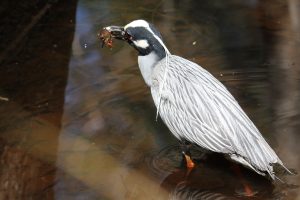
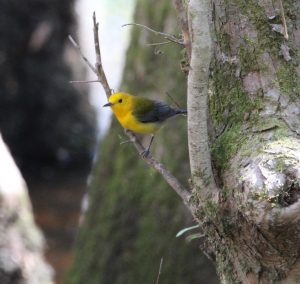 crowned night heron stalk, snatch, then expertly crunch and swallow a crawdad. Tiny yellow birds dart all around us. They are Prothonotary Warblers, one of the most prolific nesters here. Occasionally one lights long enough for a good picture. We watch carefully for river otters but never spot one. We hear a nearby barred owl.
crowned night heron stalk, snatch, then expertly crunch and swallow a crawdad. Tiny yellow birds dart all around us. They are Prothonotary Warblers, one of the most prolific nesters here. Occasionally one lights long enough for a good picture. We watch carefully for river otters but never spot one. We hear a nearby barred owl.
They do charge a fee, $10, but it is a great walk.
Santee State Park
We take the opportunity to explore our park today. It is a short walk from camp to Sinkhole Pond trail. We wind through piney forest a mile and come upon the trail namesake (s), blackwater pools. Limestone subsoil has eroded then collapsed creating tree encircled depressions. It is a lovely, tranquil setting. Well worth the walk. We chill for a spell then head on to the day use area, pretty unused today, to enjoy a quiet lunch before heading back to camp. Not all days are or need to be exciting.
A day in Congaree National Park
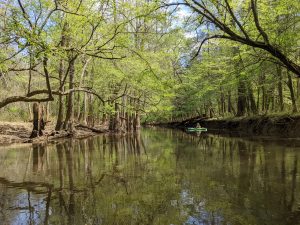 I would say that this is a park more accurately described as amazing than beautiful. It is all about a wilderness area encompassing the Congaree River floodplain forest, the largest floodplain forest remaining in the US. Just two weeks ago, and as often as 10 times a year when the Congaree overflows its banks, this area was inundated by ten feet or more of fast-moving water. Today, old growth water tupelo and bald cypress and the occasional loblolly pine tower above acres of dorovan muck (clay mixed with decaying leaves), still swamp pools, and slow-moving Cedar Creek. It is amazing how plants and creatures have evolved to survive here.
I would say that this is a park more accurately described as amazing than beautiful. It is all about a wilderness area encompassing the Congaree River floodplain forest, the largest floodplain forest remaining in the US. Just two weeks ago, and as often as 10 times a year when the Congaree overflows its banks, this area was inundated by ten feet or more of fast-moving water. Today, old growth water tupelo and bald cypress and the occasional loblolly pine tower above acres of dorovan muck (clay mixed with decaying leaves), still swamp pools, and slow-moving Cedar Creek. It is amazing how plants and creatures have evolved to survive here. 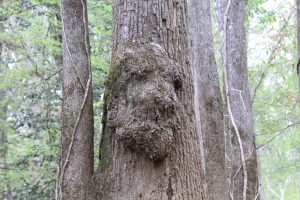 We paddle the creek. We launch in that slippery mushy muck. The air is heavy with the smell of wet earth. We maneuver around submerged and half submerged debris and limbo under fallen trees. All this with a watchful eye for the snakes (I spotted one just ½ mile into the paddle) and spiders and all that call this place home. Viewed from water level, cypress and tupelo trunks appear enormous and the cypress knees that jut from the backwaters along the creek are too many to count. Sunlight filters through the bright, spring green as the canopy overhead is just leafing out. We spot the waving white flags of a half dozen whitetail deer as they startle at our appearance. Birdsong mixes with the rustle of wind through the trees. We have this unique place pretty much to ourselves for these hours. Yep, it is amazing. There are brief moments of disappointment as the roar of jets tear through the peaceful isolation of this wild space.
We paddle the creek. We launch in that slippery mushy muck. The air is heavy with the smell of wet earth. We maneuver around submerged and half submerged debris and limbo under fallen trees. All this with a watchful eye for the snakes (I spotted one just ½ mile into the paddle) and spiders and all that call this place home. Viewed from water level, cypress and tupelo trunks appear enormous and the cypress knees that jut from the backwaters along the creek are too many to count. Sunlight filters through the bright, spring green as the canopy overhead is just leafing out. We spot the waving white flags of a half dozen whitetail deer as they startle at our appearance. Birdsong mixes with the rustle of wind through the trees. We have this unique place pretty much to ourselves for these hours. Yep, it is amazing. There are brief moments of disappointment as the roar of jets tear through the peaceful isolation of this wild space.
We stroll the visitor center boardwalk for a nice overview of the wide range of micro ecosystems that are represented in this plain. Not your typical mega National Park but a good reflection on man-kind that we still managed to attempt to protect it.
Probably an important note. Oddly, there were practically no mosquitoes our entire time in the park. Given the terrain, I suspect that is not always the case and could very well impact how much I or others appreciate the place!
Day – 2 Santee NWR
No boating today. Instead, we head to Santee National Wildlife Refuge to explore and bird. I am disappointed the Visitor Center is closed since their webpage listed it as open today. I am disappointed the cypress swamp boardwalk trail is closed because the boardwalk is in disrepair. I am a bit disappointed in birding too. It is very quiet. A glimpse of a few wood ducks is the highlight. Nature doesn’t always cooperate.
We close the day with our first South Carolina BBQ stop, D&H BBQ in Manning. We go for the buffet to maximize what we can sample. Plus, it includes dessert, pecan pie! The pulled pork is nicely seasoned. It is tasty but I prefer a bit smokier. Fried chicken is moist with light breading that is perfectly crunchy. The pie finishes the meal off nicely. To my tastes, I would give it a solid B. I picked up a South Carolina BBQ Trail map and we hope to check out a couple more of those establishments before we move on north.
